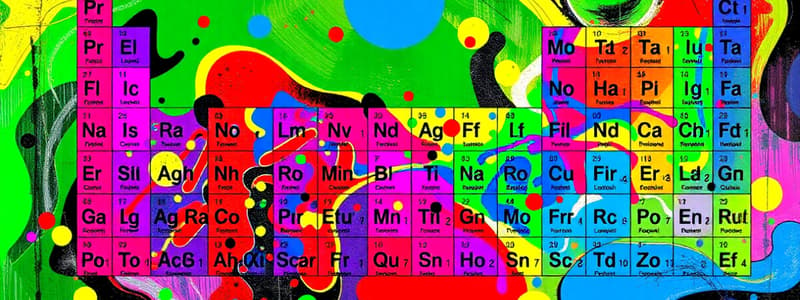Podcast
Questions and Answers
Which element is not considered a metalloid?
Which element is not considered a metalloid?
- Carbon (C) (correct)
- Germanium (Ge)
- Silicon (Si)
- Arsenic (As)
What does an atomic number represent?
What does an atomic number represent?
- The mass of an atom in atomic mass units
- The total number of atoms in a substance
- The number of neutrons in an atom
- The number of protons in an atom (correct)
Which of the following elements is classified as a gas at room temperature?
Which of the following elements is classified as a gas at room temperature?
- Gold (Au)
- Iron (Fe)
- Aluminum (Al)
- Oxygen (O) (correct)
Which of the following pairs of elements are both nonmetals?
Which of the following pairs of elements are both nonmetals?
Which element is commonly found in organic molecules?
Which element is commonly found in organic molecules?
What information can be quickly determined from the periodic table?
What information can be quickly determined from the periodic table?
Which of the following elements is a metal?
Which of the following elements is a metal?
Flashcards
Element
Element
A pure substance that cannot be broken down into simpler substances by chemical means.
Periodic Table
Periodic Table
A chart that organizes all known elements by their atomic number, electron configuration, and recurring chemical properties.
Atomic Number
Atomic Number
The number of protons in an atom's nucleus, which determines the element's identity.
Element Symbol
Element Symbol
Signup and view all the flashcards
Organic Molecules
Organic Molecules
Signup and view all the flashcards
Metals
Metals
Signup and view all the flashcards
Metalloids
Metalloids
Signup and view all the flashcards
Study Notes
Elements
- Elements are substances that cannot be broken down into anything simpler.
- Elements are classified as solids, liquids, or gases.
- Each element has a unique name, atomic number, and symbol.
- There are 118 known elements.
- Elements are organized on the periodic table.
Periodic Table
- The periodic table organizes elements.
- The periodic table helps to quickly find an element's address, atomic number, symbol, name, and atomic mass.
- The periodic table can also quickly identify if an element is a metal, nonmetal, or metalloid based on its location.
Examples of Elements
- Hydrogen (H), Helium (He) are the lightest elements
- Examples of elements found in organic molecules: Hydrogen, Carbon (C), Oxygen (O), Nitrogen (N).
- Examples of metals: Sodium (Na), Gold (Au), Silver (Ag), Iron (Fe), Copper (Cu), Aluminum (Al).
- Chlorine (Cl) is an element found in salt.
- Silicon (Si) is a metalloid found in many products.
Studying That Suits You
Use AI to generate personalized quizzes and flashcards to suit your learning preferences.




